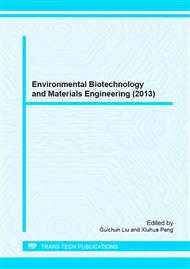[1]
C.Y. Chen, K.L. Yeh, R. Aisyah, D.J. Lee, J.S. Chang, Cultivation, photobioreactor design and harvesting of microalgae for biodiesel production: a critical review, Bioresour. Technol. 102 (2011) 71-81.
DOI: 10.1016/j.biortech.2010.06.159
Google Scholar
[2]
G.H. Huang, F. Chen, D. Wei, X.W. Zhang, G. Chen, Biodiesel production by microalgal biotechnology, Appl. Energy. 87 (2010) 38-46.
DOI: 10.1016/j.apenergy.2009.06.016
Google Scholar
[3]
Y. Chisti, Biodiesel from microalgae, Biotechnol. Adv. 25 (2007) 294-306.
Google Scholar
[4]
H.Y. Tang, M. Chen, K.Y. Simon Ng, S.O. Salley, Continuous microalgae cultivation in a photobioreactor, Biotechnol. Bioeng. 109 (2012) 2468-2474.
DOI: 10.1002/bit.24516
Google Scholar
[5]
M.E. Martínez, S. Sánchez, J.M. Jiménez, E.L. Yousfi, L. Muñoz, Nitrogen and phosphorus removal from urban wastewater by the microalga Scenedesmus obliquus, Bioresour. Technol. 73 (2000) 263-272.
DOI: 10.1016/s0960-8524(99)00121-2
Google Scholar
[6]
D. Voltolina, H. Gómez-Villa, G. Correa, Nitrogen removal and recycling by Scenedesmus obliquus in semicontinuous cultures using artificial wastewater and a simulated light and temperature cycle, Bioresour. Technol. 96 (2005) 359-362.
DOI: 10.1016/j.biortech.2004.04.004
Google Scholar
[7]
G. Markou, D. Georgakakis, Cultivation of filamentous cyanobacteria (blue-green algae) in agro-industrial wastes and wastewaters: a review, Appl. Energy. 88 (2011) 3389-3401.
DOI: 10.1016/j.apenergy.2010.12.042
Google Scholar
[8]
H.F. Yu, S.R. Jia, Y.J. Dai, Growth characteristics of the cyanobacterium Nostoc flagelliforme in photoautotrophic, mixotrophic and heterotrophic cultivation, J. Appl. Phycol. 21 (2009) 127-133.
DOI: 10.1007/s10811-008-9341-5
Google Scholar
[9]
Y.N. Liang, N. Sarkany, Y. Cui, Biomass and lipid productivities of Chlorella vulgaris under autotrophic, heterotrophic and mixotrophic growth conditions, Biotechnol. Lett. 31 (2009) 1043-1049.
DOI: 10.1007/s10529-009-9975-7
Google Scholar
[10]
M.X. Wan, P. Liu, J.L. Xia, J.N. Rosenberg, G.A. Oyler, M.J. Betenbaugh, Z.Y. Nie, G.Z. Qiu, The effect of mixotrophy on microalgal growth, lipid content, and expression levels of three pathway genes in Chlorella sorokiniana, Appl. Microbiol. Biotechnol. 91 (2011).
DOI: 10.1007/s00253-011-3399-8
Google Scholar
[11]
J.Y. Xu, W. Du, X.B. Zhao, G.L. Zhang, D.H. Liu, Microbial oil production from various carbon sources and its use for biodiesel preparation, Biofuels Bioprod. Biorefining. 7 (2013) 65-77.
DOI: 10.1002/bbb.1372
Google Scholar
[12]
A. Bhatnagar, S. Chinnasamy, M. Singh, K.C. Das, Renewable biomass production by mixotrophic algae in the presence of various carbon sources and wastewaters, Appl. Energy. 88 (2011) 3425-3431.
DOI: 10.1016/j.apenergy.2010.12.064
Google Scholar
[13]
A. Singh, P.S. Nigam, J.D. Murphy, Renewable fuels from algae: an answer to debatable land based fuels, Bioresour. Technol. 102 (2011) 10-16.
DOI: 10.1016/j.biortech.2010.06.032
Google Scholar
[14]
S. Mandal, N. Mallick, Microalga Scenedesmus obliquus as a potential source for biodiesel production, Appl. Microbiol. Biotechnol. 84 (2009) 281-291.
DOI: 10.1007/s00253-009-1935-6
Google Scholar
[15]
D. Pleissner, N.T. Eriksen, Effects of phosphorous, nitrogen, and carbon limitation on biomass composition in batch and continuous flow cultures of the heterotrophic dinoflagellate Crypthecodinium cohnii, Biotechnol. Bioeng. 109 (2012).
DOI: 10.1002/bit.24470
Google Scholar


